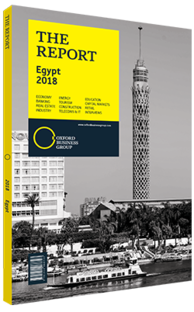Petrochemical and fertiliser exports from Egypt grow
Since the late 2000s energy production has lagged behind consumption, and a shortage of natural gas has left industrial customers scrambling for solutions. Growth in upstream production failed to keep up with downstream demand, with both oil and gas production falling below historical highs. However, as new upstream discoveries have come on-line since then, Egypt’s growing chemicals industry looks to continue its trajectory in mitigating the demand-supply deficit and boost many opportunities for engagement in the economy.
Sector Update
Despite some strong performance throughout 2017, the index of manufacturing production for chemical products reported a 12.1% decrease from 160.3 points in October to 140.8 points in November. However, as reported by the Chemical Export Council, chemical exports increased by 32% in 2017 to $4.4bn, up from $3.3bn in 2016. The council noted that plastics and rubber was the top-performing segment in the first half of the year, with $662.9m in exports, up 18% from $516.4m in the same period in 2016. In second position was fertilisers, up by 71% to $502m.
Petrochemicals
Given recent oil and gas discoveries upstream, the field of petrochemicals is one of the most important areas for development of Egypt’s industrial sector. Downstream investment is not a new undertaking. The Egyptian Petrochemical Holding Company was established in 2002 to help execute a 20-year master plan overseeing construction of 14 petrochemical complexes with 24 plants and 50 production units. “The most important issue is how to add real value to oil and gas production by enhancing the petrochemical industries,” Mohamed Maher, vice-chairman and CEO of local investment bank Prime Holding, told OBG. “With the new Suez Canal corridor project, in particular, there is a lot of focus on adding petrochemical complexes to enhance the value of gas discoveries by transforming them into polymers and fertilisers.”
Egypt is making strides thanks to both government and private sector initiatives. In September 2017 Tarek El Molla, the minister of petroleum and mineral resources, announced the establishment of an integrated petrochemicals complex near the Ain Sokhna Port, to which the government intends to provide $6.8bn until 2022. There are also plans to construct a marine berth as well as storage and shipping facilities in Damietta Port by 2020, with an investment of $160m.
Cairo-headquartered Carbon Holdings is in the process of finalising funding for the $10.8bn Tahrir Petrochemical Complex, also to be built in Ain Sokhna. When complete, it will be Egypt’s largest petrochemical project. “There is a clear correlation between a country’s per capita GDP and the production of ethylene, because petrochemical raw materials are what enable a manufacturing sector to thrive,” Basil El Baz, chairman and CEO of Carbon Holdings, told OBG. “You are always going to want to put a manufacturing facility next to the raw material source to save costs.”
Fertilisers & Phosphates
The fertiliser industry is growing in tandem with the agriculture sector (see Agriculture chapter). “We are expecting domestic demand for fertilisers to grow, given the Ministry of Agriculture’s aims to expand the arable land in the country,” Mohamed El Danaf, chairman and CEO of Helwan Fertilisers, told OBG. Egyptian company Ever-grow Fertilisers has announced plans to establish a new LE9.5bn ($625.8m) project to produce over 1m tonnes of fertiliser annually for both local use and export, starting in 2020. German construction firm Thyssen-Krupp Industrial Solutions also announced a €133m investment to expand and develop the machinery of Abu Qir Fertilisers, starting in 2018.
In 2015 the Chamber of Chemical Industries estimated that Egypt’s phosphate segment could absorb more than 10 times the level of current investment. There are plans to construct three phosphate factories in the Western Desert, as part of the government’s development strategy to roll out more agricultural and industrial projects in the New Valley Governorate.
You have reached the limit of premium articles you can view for free.
Choose from the options below to purchase print or digital editions of our Reports. You can also purchase a website subscription giving you unlimited access to all of our Reports online for 12 months.
If you have already purchased this Report or have a website subscription, please login to continue.

